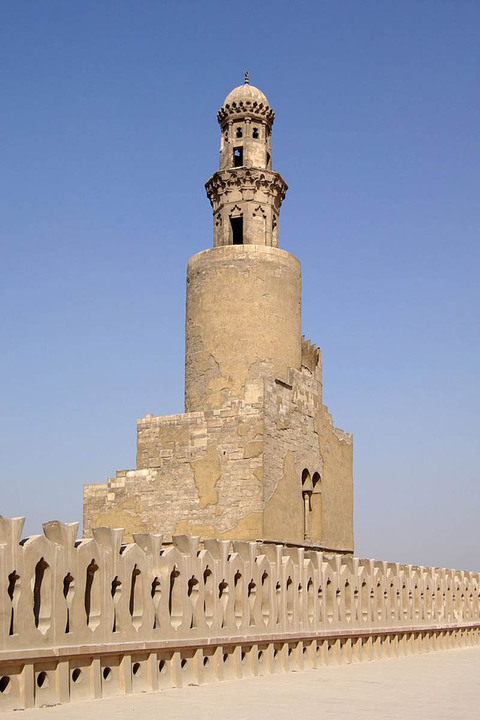Conferences and debates
Index / Activities / Conferences and debates / Series of conferences on “Great Capitals of the Medieval Islamic World: Past and present”
Series of conferences on “Great Capitals of the Medieval Islamic World: Past and present”
From May 04, 2016 until November 18, 2016Check schedules.
MADRID, CORDOBA AND SEVILLE
Casa Árabe Auditorium in Madrid (at Calle Alcalá, 62), and in Cordoba (at Calle Samuel de los Santos Gener, 9) and Seville (Hassan II Pavilion - c/Max Planck, 2 - Isla de la Cartuja)
Check schedules.
Free entry until the event’s capacity is reached.
Spanish or with simultaneous translation into Spanish.
Eleven conferences on a selection of the most important cities in the history of Islam to have been erected as the capital of an important medieval kingdom or empire.
From May 4 to November 25, 2016
MADRID, CORDOBA AND SEVILLE
Casa Árabe Auditorium in Madrid (at Calle Alcalá, 62), and in Cordoba (at Calle Samuel de los Santos Gener, 9) and Seville (Hassan II Pavilion - c/Max Planck, 2 - Isla de la Cartuja). Check schedules. Free entry until the event’s capacity is reached.
In Spanish, or with simultaneous translation into Spanish.
Casa Árabe and the Three Cultures of the Mediterranean Foundation, with the cooperation of the Sísifo Research Group of the Archeology Department at the University of Cordoba, are organizing a series of conferences titled “Great Capitals of the Medieval Islamic World: Past and present.”
Included in this series is a selection of some of the most important cities in the history of Islam which were at some time erected to become the capital of an important medieval kingdom or empire. They shall each be presented by world class specialists on this subject matter, who will examine both the history of the capital city in question (its greatest era of splendor and urban expansion, offering a visual portrayal that properly shows how the city changed and developed) with a critical, up-to-date viewpoint focused on studying and preserving the vestiges of the cities which have survived until today, dealing with topics ranging from the abandonment and pillaging of heritage sites to the consequences of war and real estate activity.
The series forms part of the activities which Casa Árabe is organizing to celebrate the 1300th anniversary of Cordoba as the capital of Al-Andalus (716-2016), a time when Cordoba became the capital of the emirate of Al-Andalus and one of the most significant political, economic and, of course, cultural centers in mankind’s history.
SPEAKERS
Prof. Dr. Abdallah Fili (Université Chouaib Doukkali, El Jadida)
A professor of Moroccan History and Archeology at the University of El Jadida, Fili holds a PhD in Archeology from the University of Lyon, under the direction of Pierre Guichard and André Bazzana. He has taken part in several archeological excavation and research projects in Sijilmasa, Fez, Volubilis, El Jadida, Aghmat, Safi and Azemmour. In 2004, along with Jean-Pierre Van Staevel, he discovered the birth site of the Almohad Mehdi, Ibn Tumart, at Igiliz of the Hargha, upon which they have completed several excavation campaigns in recent years.
Prof. Dr. Alastair Northedge (Université Paris 1 Panthéon-Sorbonne)
An archeologist and Islamic art historian of British origin, Northedge is a professor of Islamic Archeology at the Université Panthéon-Sorbonne and a member of the Orient and Mediterranean Laboratory (UMR 8167): Medieval Islam. He was the director of the Council for British Research in the Levant. He is the main specialist in the study of the Archeological Site of Samarra in Iraq, one of the most extensive archeological sites in the world, classified as a UNESCO World Heritage Site, with regard to which he has co-directed the project “The Samarra Archaeological Survey.”
Prof. Dr. Alberto León (University of Cordoba)
A tenured professor of Medieval Archeology at the University of Cordoba, León holds a university degree in Philosophy and Letters (Geography and History Section) from the University of Granada (1993) and a PhD in Philosophy and Letters (Geography and History Section) from the University of Cordoba (2001). He is a specialist in the Urbanism of Al-Andalus, medieval defensive architecture and urban archeology management.
Dr. Antonio Orihuela (CSIC-School of Arab Studies)
Holder of a degree in Architecture from the E.T.S. of Architecture in Barcelona and a PhD from the University of Seville, Orihuela earned the special PhD award for his thesis on “Nasrid Homes and Palaces.” He was a municipal architect in Granada until 1988, the year when he began to work at Granada’s School of Arab Studies, belonging to the Spanish National Research Council (CSIC), of which he is currently the director. He specializes in Islamic architecture and is a member of the research group “City Archeology and Architecture Laboratory” (LAAC). He was also an associate professor in the Department of Graphic Architectural Expression at the E.T.S. of Architecture at the University of Granada from 1994 to 1998.
Prof. Dr. Hugh Kennedy (SOAS, University of London)
An English historian and linguist, Kennedy is a professor of Arabic in the Near and Middle Eastern Languages and Cultures Department at the University of London, having become one of the most prestigious specialists worldwide in the medieval Islamic history of Europe and Asia. He is a member of the Center for Iranian Studies and the London Middle East Institute (LMEI) at the School of Oriental and African Studies. He currently co-directs the project “Economic Integration and Social Change in the Islamic World System, 800-1000CE” and has published a diverse range of historical studies which mainly revolve around the ancient territories of Syria, Iraq and Iran.
Prof. Dr. Miguel Ángel Tabales (University of Seville)
A tenured professor of Archeology with the Department of Architectural Constructions at the University of Seville, Tabales has completed numerous urban excavations in Seville and has become the main researcher of Islamic urbanism in this city. He currently runs the prestigious journal Arqueología de la Arquitectura, published by the Spanish National Research Council and the University of the Basque Country. For several years, he has taken over the management of research work, administration, preservation and dissemination of archeological subject matter for the monumental site run by the Royal Alcázar of Seville Board of Trustees.
Dr. Julio Navarro Palazón (CSIC-School of Arab Studies)
A scientist with the CSIC, he holds a PhD in Islamic Archeology and currently coordinates the tasks of the City Archeology and Architecture (LAAC) research group, which is run under the School of Arab Studies of Granada, belonging to the Spanish National Research Council (CSIC). He is one of the main researchers on Islamic architecture and urbanism worldwide. He has excavated several sites in Spain and abroad.
Dr. Patrice Cressier (CNRS, France)
With a PhD in Islamic Art History and Archeology from the Université de Paris IV-Sorbonne, Cressier is a researcher at the Centre National de la Recherche Scientifique and a member of the CIHAM-UMR in Lyon. He was named a knight of the Ordre des Palmes Académiques on October 31, 2002 and has been a member of the German Archeological Institute. He has been the Director of Studies (Ancient and Medieval) at Casa de Velázquez (1994-2002) and a member of the UMR 5648 laboratory board (“History and archeology of medieval Christian and Muslim worlds”) since this team was created at the CNRS. He has been a member of the technical commission of the Monumental Ensemble of the Alcazaba in Almería (Department of Culture of the Autonomous Regional Government of Andalusia) and has directed several monographs, congresses and international projects, amongst which we could highlight the excavations of Sabra al-Mansuriya (Kairouan, Tunisia) between the years of 2003-2008.
Dr. Rafael Blanco (University of Cordoba)
A contracted researcher with the University of Cordoba, Blanco holds a degree in Art History from the University of Cordoba (2005) and an official inter-university Master’s degree in Archeology and Heritage from the University of Cordoba, University of Huelva, University of Malaga and Universidad Pablo de Olavide (2008), as well as having earned his PhD in Archeology from the University of Cordoba. A specialist in the domestic architecture of Al-Andalus and Islamic urbanism, as well as a coordinator of different scientific culture projects within the Sísifo Research Group (University of Cordoba).
Dr. Sophie Gilotte (CNRS, France)
With a PhD in Art History and Islamic Archeology (Université de Paris IV-Sorbonne) in 2004, Gilotte is a specialist in the Muslim era on the Iberian Peninsula and in North Africa, and she is a member of the CNRS, Ciham/UMR-LYON. She has been a director of excavations at the Albalat site and president of the Madinat Albalat Association (Cáceres), as well as heading the Hoffmeyer Historical Institute project (IAM / CCHS-CSIC, Spain). She has directed or co-directed several excavations in France and Spain, and she has taken part in the Madinat al-Zahra research and development project for hardware registration.
Prof. Dr. Stéphane Pradines (Aga Khan University, United Kingdom)
With a PhD in Islamic Archeology from the Université Sorbonne Paris-IV, Pradines is a professor at the Institute for the Study of Muslim Civilisations, Aga Khan University (United Kingdom). He is a specialist in the archeology of the Middle East and East Africa. He has directed several excavations on the medieval Islamic world in Tanzania, Kenya and Egypt. He is the main specialist on the Islamic architecture and urban archeology of Cairo, with regard to which he is currently heading a project on its fortifications and urbanism, with a special focus on the eras of the Fatimids and Ayyubids. He was responsible for Islamic Archeology at the IFAO (Cairo) from 2001 to 2012 and is a professor of Islamic Archeology at the University of Cairo, the city where he created the first Islamic Archeology Field School in in Egypt. He is also an associate researcher at the CNRS in Paris, Orient et Mediterranée, the editor of Islamic Archeological Studies, a proofreader for the Journal of Islamic Archaeology and a member of the editorial team of the Journal of the Dominican Institute (MIDEO, Cairo).
CONFERENCES IN CORDOBA
Thursday, May 5, 2016
Damascus, Syria, by Hugh Kennedy (SOAS, University of London)
Thursday, May 26, 2016
Marrakesh, Morocco, by Patrice Cressier (CNRS, France)
Tuesday, June 9, 2016
Seville, Spain, by Miguel Ángel Tabales (University of Seville)
Wednesday, June 22, 2016
Murcia, Spain, by Julio Navarro Palazón (CSIC-School of Arab Studies)
Wednesday, June 29, 2016
Granada, Spain, by Antonio Orihuela (CSIC-School of Arab Studies)
Thursday, September 22, 2016
Cordoba, Spain, by Alberto León (University of Cordoba)
Thursday, September 29, 2016
Cordoba. Present (Spain), by Rafael Blanco (University of Cordoba)
Wednesday, October 19, 2016
Sabra al-Mansuriyya, Tunisia, by Sophie Gilotte (CNRS, France)
Thursday, October 27
Baghdad-Samarra, Iraq, by Alastair Northedge (Université Paris 1 Panthéon-Sorbonne)
Wednesday, November 16, 2016
Fez, Morocco, Abdallah Fili (Université Chouaib Doukkali, El Jadida)
CONFERENCES IN MADRID
Wednesday, May 4, 2016
Damascus, Syria, by Hugh Kennedy (SOAS, University of London)
Wednesday, June 8, 2016
Seville, Spain, by Miguel Ángel Tabales (University of Seville)
Thursday, June 23, 2016
Murcia, Spain, by Julio Navarro Palazón (CSIC-School of Arab Studies)
Thursday, June 30, 2016
Granada, Spain, by Antonio Orihuela (CSIC-School of Arab Studies)
Wednesday, September 21, 2016
Cordoba. Past (Spain), Alberto León (University of Cordoba)
Wednesday, September 28, 2016
Cordoba. Present (Spain), Rafael Blanco (University of Cordoba)
Thursday, October 20, 2016
Sabra al-Mansuriyya, Tunisia, by Sophie Gilotte (CNRS, France)
Wednesday, October 26, 2016
Baghdad-Samarra, Iraq, by Alastair Northedge (Université Paris 1 Panthéon-Sorbonne)
Wednesday, November 2, 2016
Marrakesh, Morocco, by Patrice Cressier (CNRS, France)
Thursday, November 17, 2016
Fez, Morocco, Abdallah Fili (Université Chouaib Doukkali, El Jadida)
November 2016
Cairo-Fustat, Egypt, Stéphane Pradines (Aga Khan University, United Kingdom)
CONFERENCES IN SEVILLE
Tuesday, May 10, 2016
Seville, Spain, by Miguel Ángel Tabales (University of Seville)
Wednesday, May 25, 2016
Marrakesh, Morocco, by Patrice Cressier (CNRS, France)
Tuesday, June 21, 2016
Murcia, Spain, by Julio Navarro Palazón (CSIC-School of Arab Studies)
Tuesday, June 28, 2016
Granada, Spain, by Antonio Orihuela (CSIC-School of Arab Studies)
Tuesday, September 20, 2016
Cordoba. Present (Spain), by Rafael Blanco (University of Cordoba)
Tuesday, October 18, 2016
Sabra al-Mansuriyya, Tunisia, by Sophie Gilotte (CNRS, France)
Tuesday, November 15, 2016
Fez, Morocco, Abdallah Fili (Université Chouaib Doukkali, El Jadida)
-
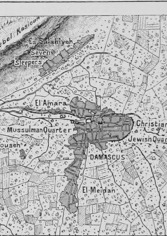
Damascus: Change and continuity in the Late Middle Ages
May 04, 20167:00 p.m.MADRIDCasa Árabe Auditorium (at Calle Alcalá, 62). 7:00 p.m. Free entry until the event’s capacity is reached.In English, with simultaneous translation into Spanish.First conference in Madrid forming part of the series on “Great Capitals of the Medieval Islamic World: Past and present”Casa Árabe and the Three Cultures of the Mediterranean Foundation, with the cooperation of the Sísifo Research Group of the Archeology Department at the University of Cordoba, have organized this conference given by Hugh Kennedy, SOAS - University of London.The conference will focus on the history and topography of Damascus from the Byzantine period to the twelfth century. It will mainly deal with the importance of this city as the capital of the Umayyad Caliphate, the uprise of the Abbasid government and its negative effect on the city’s prosperity, as well as the later role played by the Seleucid dynasty. The changes in the urban street layout, the Umayyad mosque and the reconstruction of the first fortress will all be discussed. Last of all, it will deal with this historical city’s reality within the context of the twentieth and twenty-first centuries.Conference information sheetHugh Kennedy is a professor in the Near and Middle Eastern Languages and Cultures Department at the University of London. He is one of the most prestigious specialists in the medieval Islamic history of Europe and Asia. He is a member of the Center for Iranian Studies and the London Middle East Institute (LMEI) at the School of Oriental and African Studies. He currently co-directs the project “Economic Integration and Social Change in the Islamic World System, 800-1000 CE” and has published a wide range of historical studies which mainly revolve around the ancient territories of Syria and Iraq.
Organize: Casa Árabe and Fundación Tres Culturas del Mediterráneo
Collaborates: The Sísifo Research Group of the Archeology Department at the University of Cordoba -

Damascus: Change and continuity in the Late Middle Ages
May 05, 20167:30 p.m.CóRDOBACasa Árabe Auditorium (at Calle Samuel de los Santos Gener, 9) 7:30 p.m. Free entry until the event’s capacity is reached.In English, with simultaneous translation into Spanish.First conference in Cordoba forming part of the series on “Great Capitals of the Medieval Islamic World: Past and present”Casa Árabe and the Three Cultures of the Mediterranean Foundation, with the cooperation of the Sísifo Research Group of the Archeology Department at the University of Cordoba, have organized this conference given by Hugh Kennedy, SOAS - University of London.This conference will focus on the history and topography of Damascus from the Byzantine period to the twelfth century. It will mainly deal with the importance of this city as the capital of the Umayyad Caliphate, the uprise of the Abbasid government and its negative effect on the city’s prosperity, as well as the later role played by the Seleucid dynasty. The changes in the urban street layout, the Umayyad mosque and the reconstruction of the first fortress will all be discussed. Last of all, it will deal with this historical city’s reality within the context of the twentieth and twenty-first centuries.Conference information sheetHugh Kennedy is a professor in the Near and Middle Eastern Languages and Cultures Department at the University of London. He is one of the most prestigious specialists in the medieval Islamic history of Europe and Asia. He is a member of the Center for Iranian Studies and the London Middle East Institute (LMEI) at the School of Oriental and African Studies. He currently co-directs the project “Economic Integration and Social Change in the Islamic World System, 800-1000 CE” and has published a diverse range of historical studies which mainly revolve around the ancient territories of Syria and Iraq.
Organize: Casa Árabe and Fundación Tres Culturas del Mediterráneo
Collaborates: The Sísifo Research Group of the Archeology Department at the University of Cordoba -
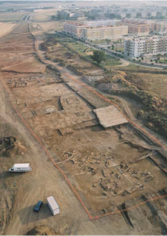 Excavaciones previas a la construcción de la Ronda de Poniente, Córdoba. Foto: C. Camacho, M. Haro y C. Pérez (AAA, 2004)Qurtuba, the Great Umayyad Capital of the West: Between past and presentSeptember 20, 20167:30 p.m.SEVILLEPabellón Hassan II - C/ Max Planck 2. Isla de la Cartuja 7:30 p.m. Free entry until the event’s capacity is reached.In SpanishRafael Blanco, of the University of Cordoba, will be giving this conference in Seville.About six years after the Islamic conquest of the Iberian Peninsula, the ruler al-Hurr established the capital of Al-Andalus in Cordoba. In the mid-eighth century, Abd al-Rahman I managed to escape the massacre of his dynasty in the East and chose this city as the capital of an independent emirate, culminating with the proclamation of the Umayyad Caliphate of Cordoba by Abd al-Rahman III in 929. In 936, this first caliphate would create a new city to its west: Madinat al-Zahra’. Later that same year, Almanzor would create another to the east, Madinat al-Zahira.Extensive neighborhoods containing palaces, vegetable gardens, orchards, homes, mosques, baths, cemeteries and more were developed around these three settlements, to a great extent unburied after hundreds of excavations completed over the last few decades. By studying these sites, we can now create a detailed overview of Umayyad Cordoba (in the eighth and ninth centuries), a city beyond compare for centuries in Europe and the Islamic West.This conference will also deal with the complex co-existence between these important vestiges of the medieval metropolis and today’s city. Since the 1980’s, it has been difficult to find a good fit between past and present, often causing different conflicts over heritage sites.
Excavaciones previas a la construcción de la Ronda de Poniente, Córdoba. Foto: C. Camacho, M. Haro y C. Pérez (AAA, 2004)Qurtuba, the Great Umayyad Capital of the West: Between past and presentSeptember 20, 20167:30 p.m.SEVILLEPabellón Hassan II - C/ Max Planck 2. Isla de la Cartuja 7:30 p.m. Free entry until the event’s capacity is reached.In SpanishRafael Blanco, of the University of Cordoba, will be giving this conference in Seville.About six years after the Islamic conquest of the Iberian Peninsula, the ruler al-Hurr established the capital of Al-Andalus in Cordoba. In the mid-eighth century, Abd al-Rahman I managed to escape the massacre of his dynasty in the East and chose this city as the capital of an independent emirate, culminating with the proclamation of the Umayyad Caliphate of Cordoba by Abd al-Rahman III in 929. In 936, this first caliphate would create a new city to its west: Madinat al-Zahra’. Later that same year, Almanzor would create another to the east, Madinat al-Zahira.Extensive neighborhoods containing palaces, vegetable gardens, orchards, homes, mosques, baths, cemeteries and more were developed around these three settlements, to a great extent unburied after hundreds of excavations completed over the last few decades. By studying these sites, we can now create a detailed overview of Umayyad Cordoba (in the eighth and ninth centuries), a city beyond compare for centuries in Europe and the Islamic West.This conference will also deal with the complex co-existence between these important vestiges of the medieval metropolis and today’s city. Since the 1980’s, it has been difficult to find a good fit between past and present, often causing different conflicts over heritage sites.
Organize: Casa Árabe and Fundación Tres Culturas del Mediterráneo -
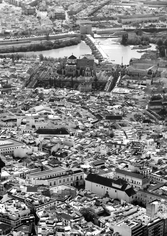 © Manuel Gutierrez GuerreroCordoba: The “hadira” of Al-Andalus, more than just the faded reflection of a splendid past.September 21, 20167:00 p.m.MADRIDCasa Árabe Auditorium (at Calle Alcalá, 62). 7:00 p.m. Free entry until the event’s capacity is reached.In SpanishAlberto León, from the University of Cordoba, will be giving this conference at Casa Árabe’s auditorium in Madrid.The capital of Al-Andalus during the centuries of Umayyad power is a necessary point of reference in any studies on the city’s Islamic past. However, the focus of attention has revolved mainly around the most monumental remains and the testimonials found in documentary sources, including sites like the Aljama Mosque, or elements more greatly distorted by historiographical stereotypes, as is the case with the winding layout of the city’s old historical neighborhood. Beyond just these clichés, today’s city houses information of incomparable historical value about the evolution of urban society in Al-Andalus.Many questions still remain unstudied, and many different viewpoints may be used to examine them. For instance, there is the decisive role played by the capital in the development of a fully Islamic urban landscape, sponsored by the milieus of Umayyad power, but with a notable role also played by private initiative. Then there is the change undergone in the city after the Umayyad caliphate fell. Answers can be found to many of these questions in currently existing, visible forms of evidence, provided that we look at them with the proper interest and use the information appropriately.
© Manuel Gutierrez GuerreroCordoba: The “hadira” of Al-Andalus, more than just the faded reflection of a splendid past.September 21, 20167:00 p.m.MADRIDCasa Árabe Auditorium (at Calle Alcalá, 62). 7:00 p.m. Free entry until the event’s capacity is reached.In SpanishAlberto León, from the University of Cordoba, will be giving this conference at Casa Árabe’s auditorium in Madrid.The capital of Al-Andalus during the centuries of Umayyad power is a necessary point of reference in any studies on the city’s Islamic past. However, the focus of attention has revolved mainly around the most monumental remains and the testimonials found in documentary sources, including sites like the Aljama Mosque, or elements more greatly distorted by historiographical stereotypes, as is the case with the winding layout of the city’s old historical neighborhood. Beyond just these clichés, today’s city houses information of incomparable historical value about the evolution of urban society in Al-Andalus.Many questions still remain unstudied, and many different viewpoints may be used to examine them. For instance, there is the decisive role played by the capital in the development of a fully Islamic urban landscape, sponsored by the milieus of Umayyad power, but with a notable role also played by private initiative. Then there is the change undergone in the city after the Umayyad caliphate fell. Answers can be found to many of these questions in currently existing, visible forms of evidence, provided that we look at them with the proper interest and use the information appropriately.
Organize: Casa Árabe and Fundación Tres Culturas -
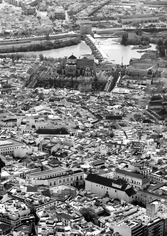 © Manuel Gutierrez GuerreroCordoba: The “hadira” of Al-Andalus, more than just the faded reflection of a splendid past.September 22, 20167:30 p.m.CóRDOBACasa Árabe Auditorium (at Calle Samuel de los Santos Gener, 9) 7:30 p.m. Free entry until the event’s capacity is reached.In SpanishAlberto León, a professor at the University of Cordoba, will be giving this conference at Casa Árabe’s auditorium in Cordoba.The capital of Al-Andalus during the centuries of Umayyad power is a necessary point of reference in any studies on the city’s Islamic past. However, the focus of attention has revolved mainly around the most monumental remains and the testimonials found in documentary sources, including sites like the Aljama Mosque, or elements more greatly distorted by historiographical stereotypes, as is the case with the winding layout of the city’s old historical neighborhood. Beyond just these clichés, today’s city houses information of incomparable historical value about the evolution of urban society in Al-Andalus.Many questions still remain unstudied, and many different viewpoints may be used to examine them. For instance, there is the decisive role played by the capital in the development of a fully Islamic urban landscape, sponsored by the milieus of Umayyad power, but with a notable role also played by private initiative. Then there is the change undergone in the city after the Umayyad caliphate fell. Answers can be found to many of these questions in currently existing, visible forms of evidence, provided that we look at them with the proper interest and use the information appropriately.
© Manuel Gutierrez GuerreroCordoba: The “hadira” of Al-Andalus, more than just the faded reflection of a splendid past.September 22, 20167:30 p.m.CóRDOBACasa Árabe Auditorium (at Calle Samuel de los Santos Gener, 9) 7:30 p.m. Free entry until the event’s capacity is reached.In SpanishAlberto León, a professor at the University of Cordoba, will be giving this conference at Casa Árabe’s auditorium in Cordoba.The capital of Al-Andalus during the centuries of Umayyad power is a necessary point of reference in any studies on the city’s Islamic past. However, the focus of attention has revolved mainly around the most monumental remains and the testimonials found in documentary sources, including sites like the Aljama Mosque, or elements more greatly distorted by historiographical stereotypes, as is the case with the winding layout of the city’s old historical neighborhood. Beyond just these clichés, today’s city houses information of incomparable historical value about the evolution of urban society in Al-Andalus.Many questions still remain unstudied, and many different viewpoints may be used to examine them. For instance, there is the decisive role played by the capital in the development of a fully Islamic urban landscape, sponsored by the milieus of Umayyad power, but with a notable role also played by private initiative. Then there is the change undergone in the city after the Umayyad caliphate fell. Answers can be found to many of these questions in currently existing, visible forms of evidence, provided that we look at them with the proper interest and use the information appropriately.
Organize: Casa Árabe and Fundación Tres Culturas -
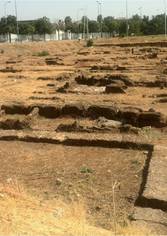 Vista actual de parte de los arrabales omeyas occidentales excavados en Córdoba. (Foto: R. Blanco)Qurtuba: Today’s Memory of the Umayyad Capital of Al-AndalusSeptember 28, 20167:00 p.m.MADRIDCasa Árabe Auditorium (at Calle Alcalá, 62). 7:00 p.m. Free entry until the event’s capacity is reached.In SpanishRafael Blanco, a professor from the University of Cordoba, will be giving this conference at the Casa Árabe headquarters in Madrid.About six years after the Muslim conquest of Al-Andalus, the ruler al-Hurr set up his capital in Qurtuba. It underwent its greatest expansion in the tenth century, by then the seat of the new Umayyad Caliphate of the West, creating a vast conurbation with the cities of al-Zahra’ to the west and al-Zahira to the east, which would last until the “fitna” or civil war in the early eleventh century.The memory of this Umayyad Cordoba remained present in the collective mindset for centuries, with its ancient Aljama Mosque as an obvious icon for the city’s splendid past. However, the notable urban growth experienced by the city in recent decades –perhaps only comparable to that which occurred in “Qurtuba” itself during the tenth century– has also gradually revealed numerous interesting layers within that great megalopolis of Al-Andalus, generally unseen by tourists and unheard of by the people of Cordoba themselves, whose main point of reference continues to be the Mosque-Cathedral.Finding a way to fit such extensive, important archeological heritage into today’s city has been a very complex task, above all since the 1980’s, often leading to conflicts over heritage sites, a topic that will be dealt with at this conference.
Vista actual de parte de los arrabales omeyas occidentales excavados en Córdoba. (Foto: R. Blanco)Qurtuba: Today’s Memory of the Umayyad Capital of Al-AndalusSeptember 28, 20167:00 p.m.MADRIDCasa Árabe Auditorium (at Calle Alcalá, 62). 7:00 p.m. Free entry until the event’s capacity is reached.In SpanishRafael Blanco, a professor from the University of Cordoba, will be giving this conference at the Casa Árabe headquarters in Madrid.About six years after the Muslim conquest of Al-Andalus, the ruler al-Hurr set up his capital in Qurtuba. It underwent its greatest expansion in the tenth century, by then the seat of the new Umayyad Caliphate of the West, creating a vast conurbation with the cities of al-Zahra’ to the west and al-Zahira to the east, which would last until the “fitna” or civil war in the early eleventh century.The memory of this Umayyad Cordoba remained present in the collective mindset for centuries, with its ancient Aljama Mosque as an obvious icon for the city’s splendid past. However, the notable urban growth experienced by the city in recent decades –perhaps only comparable to that which occurred in “Qurtuba” itself during the tenth century– has also gradually revealed numerous interesting layers within that great megalopolis of Al-Andalus, generally unseen by tourists and unheard of by the people of Cordoba themselves, whose main point of reference continues to be the Mosque-Cathedral.Finding a way to fit such extensive, important archeological heritage into today’s city has been a very complex task, above all since the 1980’s, often leading to conflicts over heritage sites, a topic that will be dealt with at this conference.
Organize: Casa Árabe and Fundación Tres Culturas del Mediterráneo -
 Vista actual de parte de los arrabales omeyas occidentales excavados en Córdoba. (Foto: R. Blanco)Qurtuba: Today’s Memory of the Umayyad Capital of Al-AndalusSeptember 29, 20167:30 p.m.CóRDOBACasa Árabe Auditorium (at Calle Samuel de los Santos Gener, 9) 7:30 p.m. Free entry until the event’s capacity is reached.In SpanishRafael Blanco, a professor from the University of Cordoba, will be giving this conference at the Casa Árabe headquarters in Cordoba.About six years after the Muslim conquest of Al-Andalus, the ruler al-Hurr set up his capital in Qurtuba. It underwent its greatest expansion in the tenth century, by then the seat of the new Umayyad Caliphate of the West, creating a vast conurbation with the cities of al-Zahra’ to the west and al-Zahira to the east, which would last until the “fitna” or civil war in the early eleventh century.The memory of this Umayyad Cordoba remained present in the collective mindset for centuries, with its ancient Aljama Mosque as an obvious icon for the city’s splendid past. However, the notable urban growth experienced by the city in recent decades –perhaps only comparable to that which occurred in “Qurtuba” itself during the tenth century– has also gradually revealed numerous interesting layers within that great megalopolis of Al-Andalus, generally unseen by tourists and unheard of by the people of Cordoba themselves, whose main point of reference continues to be the Mosque-Cathedral.Finding a way to fit such extensive, important archeological heritage into today’s city has been a very complex task, above all since the 1980’s, often leading to conflicts over heritage sites, a topic that will be dealt with at this conference.
Vista actual de parte de los arrabales omeyas occidentales excavados en Córdoba. (Foto: R. Blanco)Qurtuba: Today’s Memory of the Umayyad Capital of Al-AndalusSeptember 29, 20167:30 p.m.CóRDOBACasa Árabe Auditorium (at Calle Samuel de los Santos Gener, 9) 7:30 p.m. Free entry until the event’s capacity is reached.In SpanishRafael Blanco, a professor from the University of Cordoba, will be giving this conference at the Casa Árabe headquarters in Cordoba.About six years after the Muslim conquest of Al-Andalus, the ruler al-Hurr set up his capital in Qurtuba. It underwent its greatest expansion in the tenth century, by then the seat of the new Umayyad Caliphate of the West, creating a vast conurbation with the cities of al-Zahra’ to the west and al-Zahira to the east, which would last until the “fitna” or civil war in the early eleventh century.The memory of this Umayyad Cordoba remained present in the collective mindset for centuries, with its ancient Aljama Mosque as an obvious icon for the city’s splendid past. However, the notable urban growth experienced by the city in recent decades –perhaps only comparable to that which occurred in “Qurtuba” itself during the tenth century– has also gradually revealed numerous interesting layers within that great megalopolis of Al-Andalus, generally unseen by tourists and unheard of by the people of Cordoba themselves, whose main point of reference continues to be the Mosque-Cathedral.Finding a way to fit such extensive, important archeological heritage into today’s city has been a very complex task, above all since the 1980’s, often leading to conflicts over heritage sites, a topic that will be dealt with at this conference.
Organize:Casa Árabe and Fundación Tres Culturas del Mediterráneo -
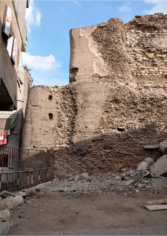 Vista de Qalat al-Qabsh, El Cairo (Foto: S. Pradines, 2015).Islamic Cairo and Fustat: From Arab conquest to the French expeditionOctober 05, 20167:00 p.m.MADRIDCasa Árabe Auditorium (at Calle Alcalá, 62). 7:00 p.m. Free entry until the event’s capacity is reached.In SpanishStephane Pradines, a professor from the Aga Khan University in the United Kingdom, will be giving this conference at the Casa Árabe headquarters in Madrid.While the history of Cairo has been well-known in Arab and Latin sources, the archeology of Cairo has remained practically terra incognita. We have no archeological evidence form the Abbasid cities of al-Askar and al-Qatai, and our knowledge about the urbanization and layout planning of the Fatimid city has essentially been handed down to us by historians on the basis of the writings of Maqrizi. If to this we add a theoretical model developed by historians, we end up with a biased archeological viewpoint of the city, limited to just the excavations in the ancient city of Misr-Fustat. Therefore, the excavations by the Aga Khan Trust for Culture and the French Institute of Archeology have provided an incipient, innovative body of knowledge on medieval Cairo that may be destroyed at any time by modern construction and corrupt businessmen.
Vista de Qalat al-Qabsh, El Cairo (Foto: S. Pradines, 2015).Islamic Cairo and Fustat: From Arab conquest to the French expeditionOctober 05, 20167:00 p.m.MADRIDCasa Árabe Auditorium (at Calle Alcalá, 62). 7:00 p.m. Free entry until the event’s capacity is reached.In SpanishStephane Pradines, a professor from the Aga Khan University in the United Kingdom, will be giving this conference at the Casa Árabe headquarters in Madrid.While the history of Cairo has been well-known in Arab and Latin sources, the archeology of Cairo has remained practically terra incognita. We have no archeological evidence form the Abbasid cities of al-Askar and al-Qatai, and our knowledge about the urbanization and layout planning of the Fatimid city has essentially been handed down to us by historians on the basis of the writings of Maqrizi. If to this we add a theoretical model developed by historians, we end up with a biased archeological viewpoint of the city, limited to just the excavations in the ancient city of Misr-Fustat. Therefore, the excavations by the Aga Khan Trust for Culture and the French Institute of Archeology have provided an incipient, innovative body of knowledge on medieval Cairo that may be destroyed at any time by modern construction and corrupt businessmen.
Organize:Casa Árabe and Fundación Tres Culturas del Mediterráneo -
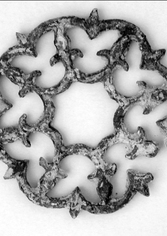 Sondage 3 (UF 3006 b). « Couronne de lumière ».Sabra al-Mansūriya. From Fatimid capital to barren city at the gates of KairouanOctober 19, 20167:30 p.m.CóRDOBACasa Árabe Auditorium (C/ Samuel de los Santos Gener, 9) 7:30 p.m. Free entrance until the event’s capacity is reached.This conference is taking place at Casa Árabe’s headquarters in Córdoba.Sabra al-Mansuriya is a paradigmatic example of how the caliphal dynasty founded a city, in this case designed to house both the State apparatus and all of the economic and social activities which fell under its control. Built in 947 by the third Fatimid caliph, Al-Mansur, it was this Shia dynasty’s second capital, erected across from Kairouan –the ancient metropolis of Ifriqiya– in a situation comparable to that of Madinat al-Zahra’ and Cordoba. When the court left it behind to take up residence in Cairo (founded in 972), the city was left under the command of the Zirid governors, who ushered in its era of greatest splendor. Nevertheless, this city lasted little more than a century, having been destroyed by the Banu Hilal in 1057. We shall attempt to recreate its brief history on the basis of written sources and the most recent excavations. A highlight will be placed on the complex relationship that existed with its neighboring city of Kairouan, concluding with the problems which have arisen in the city’s preservation today, in what constitutes a typical environment of twenty-first century urban development.
Sondage 3 (UF 3006 b). « Couronne de lumière ».Sabra al-Mansūriya. From Fatimid capital to barren city at the gates of KairouanOctober 19, 20167:30 p.m.CóRDOBACasa Árabe Auditorium (C/ Samuel de los Santos Gener, 9) 7:30 p.m. Free entrance until the event’s capacity is reached.This conference is taking place at Casa Árabe’s headquarters in Córdoba.Sabra al-Mansuriya is a paradigmatic example of how the caliphal dynasty founded a city, in this case designed to house both the State apparatus and all of the economic and social activities which fell under its control. Built in 947 by the third Fatimid caliph, Al-Mansur, it was this Shia dynasty’s second capital, erected across from Kairouan –the ancient metropolis of Ifriqiya– in a situation comparable to that of Madinat al-Zahra’ and Cordoba. When the court left it behind to take up residence in Cairo (founded in 972), the city was left under the command of the Zirid governors, who ushered in its era of greatest splendor. Nevertheless, this city lasted little more than a century, having been destroyed by the Banu Hilal in 1057. We shall attempt to recreate its brief history on the basis of written sources and the most recent excavations. A highlight will be placed on the complex relationship that existed with its neighboring city of Kairouan, concluding with the problems which have arisen in the city’s preservation today, in what constitutes a typical environment of twenty-first century urban development. -
 Sondage 3 (UF 3006 b). « Couronne de lumière ».Sabra al-Mansūriya. From Fatimid capital to barren city at the gates of KairouanOctober 20, 20167:00 p.m.MADRIDCasa Árabe Auditorium (at Calle Alcalá, 62). 7:00 p.m. Free entrance until the event’s capacity is reached.This conference is taking place at Casa Árabe’s headquarters in Madrid.Sabra al-Mansuriya is a paradigmatic example of how the caliphal dynasty founded a city, in this case designed to house both the State apparatus and all of the economic and social activities which fell under its control. Built in 947 by the third Fatimid caliph, Al-Mansur, it was this Shia dynasty’s second capital, erected across from Kairouan –the ancient metropolis of Ifriqiya– in a situation comparable to that of Madinat al-Zahra’ and Cordoba. When the court left it behind to take up residence in Cairo (founded in 972), the city was left under the command of the Zirid governors, who ushered in its era of greatest splendor. Nevertheless, this city lasted little more than a century, having been destroyed by the Banu Hilal in 1057. We shall attempt to recreate its brief history on the basis of written sources and the most recent excavations. A highlight will be placed on the complex relationship that existed with its neighboring city of Kairouan, concluding with the problems which have arisen in the city’s preservation today, in what constitutes a typical environment of twenty-first century urban development.
Sondage 3 (UF 3006 b). « Couronne de lumière ».Sabra al-Mansūriya. From Fatimid capital to barren city at the gates of KairouanOctober 20, 20167:00 p.m.MADRIDCasa Árabe Auditorium (at Calle Alcalá, 62). 7:00 p.m. Free entrance until the event’s capacity is reached.This conference is taking place at Casa Árabe’s headquarters in Madrid.Sabra al-Mansuriya is a paradigmatic example of how the caliphal dynasty founded a city, in this case designed to house both the State apparatus and all of the economic and social activities which fell under its control. Built in 947 by the third Fatimid caliph, Al-Mansur, it was this Shia dynasty’s second capital, erected across from Kairouan –the ancient metropolis of Ifriqiya– in a situation comparable to that of Madinat al-Zahra’ and Cordoba. When the court left it behind to take up residence in Cairo (founded in 972), the city was left under the command of the Zirid governors, who ushered in its era of greatest splendor. Nevertheless, this city lasted little more than a century, having been destroyed by the Banu Hilal in 1057. We shall attempt to recreate its brief history on the basis of written sources and the most recent excavations. A highlight will be placed on the complex relationship that existed with its neighboring city of Kairouan, concluding with the problems which have arisen in the city’s preservation today, in what constitutes a typical environment of twenty-first century urban development. -
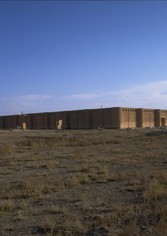 Baghdad and Samarra: Imperial capitals of the Abbasid CaliphateOctober 26, 20167:00 p.m.MADRIDCasa Árabe Auditorium (at Calle Alcalá, 62). 7:00 p.m. Free entrance until the event’s capacity is reached.In English and Spanish, with simultaneous translation.Casa Árabe and the Three Cultures of the Mediterranean Foundation, with the cooperation of the Sísifo Research Group at the University of Cordoba’s Archeology Department, have organized this conference given by Alastair Northedge (Université Paris 1 Panthéon-Sorbonne).After the founding of the Abbasid Caliphate in 750, a new capital became necessary: Baghdad (762), near the Sassanid city of Ctesifonte. This city is extensively described in texts, but nothing from the original city has been preserved. The earliest monuments preserved date back to the thirteenth century, including the Madrasa Mustansiriyya and other similar buildings. Its initial layout was based on a circular design of the governmental city, an innovation for the era, surrounded by large unfortified suburbs. Though we know little about early Baghdad’s architecture and urban planning, it can be understood through the well-preserved vestiges of the second Abbasid capital: Samarra (836-892). The ruins there maintain practically the full city layout, the arrangement of which can be seen, as can the wonderful architecture of the Al-Mutawakkil Mosque, with its famous spiral minaret. Today, these remains have suffered the effects of war and economic development, but a good portion of the site in Samarra endures.Alastair Northedge is an archeologist and Islamic art historian of British origin. He is a professor of Islamic Archeology at the Université Panthéon-Sorbonne and a member of the Orient and Mediterranean Laboratory (UMR 8167): Medieval Islam. He was the director of the Council for British Research in the Levant. He is the main specialist in the study of the Archeological Site of Samarra in Iraq, one of the most extensive archeological sites in the world, classified as a UNESCO World Heritage Site, with regard to which he has co-directed the project “The Samarra Archaeological Survey.”
Baghdad and Samarra: Imperial capitals of the Abbasid CaliphateOctober 26, 20167:00 p.m.MADRIDCasa Árabe Auditorium (at Calle Alcalá, 62). 7:00 p.m. Free entrance until the event’s capacity is reached.In English and Spanish, with simultaneous translation.Casa Árabe and the Three Cultures of the Mediterranean Foundation, with the cooperation of the Sísifo Research Group at the University of Cordoba’s Archeology Department, have organized this conference given by Alastair Northedge (Université Paris 1 Panthéon-Sorbonne).After the founding of the Abbasid Caliphate in 750, a new capital became necessary: Baghdad (762), near the Sassanid city of Ctesifonte. This city is extensively described in texts, but nothing from the original city has been preserved. The earliest monuments preserved date back to the thirteenth century, including the Madrasa Mustansiriyya and other similar buildings. Its initial layout was based on a circular design of the governmental city, an innovation for the era, surrounded by large unfortified suburbs. Though we know little about early Baghdad’s architecture and urban planning, it can be understood through the well-preserved vestiges of the second Abbasid capital: Samarra (836-892). The ruins there maintain practically the full city layout, the arrangement of which can be seen, as can the wonderful architecture of the Al-Mutawakkil Mosque, with its famous spiral minaret. Today, these remains have suffered the effects of war and economic development, but a good portion of the site in Samarra endures.Alastair Northedge is an archeologist and Islamic art historian of British origin. He is a professor of Islamic Archeology at the Université Panthéon-Sorbonne and a member of the Orient and Mediterranean Laboratory (UMR 8167): Medieval Islam. He was the director of the Council for British Research in the Levant. He is the main specialist in the study of the Archeological Site of Samarra in Iraq, one of the most extensive archeological sites in the world, classified as a UNESCO World Heritage Site, with regard to which he has co-directed the project “The Samarra Archaeological Survey.”
Organize: Casa Árabe and Fundación Tres Culturas del Mediterráneo -
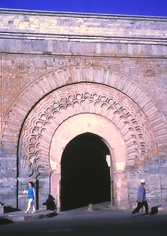 Photo by Patrice Cressier
Photo by Patrice CressierMarrakesh: Cultural melting pot to the north of the Atlas.
November 02, 2016 7:00 p.m.MADRIDCasa Árabe Auditorium (at Calle Alcalá, 62). 7:00 p.m. Free entry until the event’s capacity is reached.In Spanish.Patrice Cressier, researcher at CNRS is offering this conference as part of our series on Medieval Capitals.Including the Almoravids, the city’s founders, four of the six great dynasties that have ruled Morocco made Marrakesh their capital, either permanently or temporarily. Although it was the southernmost of the places known as the “Imperial Cities,” neither its architecture nor its urbanism can be defined as Saharan, contrary to the commonly purported clichés. However, despite lying amid natural surroundings that are quite unfavorable, in principle, it has ended up becoming a privileged place in which the tribal Berber substrate has been enriched with contributions from Al-Andalus and the Middle East, giving the city its own unique personality. In this brief review of Marrakesh’s urban history, we will be concentrating on the time when the city was founded and the first two stages within its growth, the Almoravid and Almohad periods (11th-12th centuries). We will also examine under what conditions this wealthy historical heritage has been preserved and to what extent it has been integrated into the city’s current promotion of tourism, and therefore into the city’s economic life.
Organize: Casa Árabe and Fundación Tres Culturas del Mediterráneo -
 Vivienda excavada en 2005 bajo la ampliación almorávide de la Mezquita de al-Qarawiyyin (Fez). Foto: A. Ettahiri, A. Fili, J.P. Van Staëvel (2012).
Vivienda excavada en 2005 bajo la ampliación almorávide de la Mezquita de al-Qarawiyyin (Fez). Foto: A. Ettahiri, A. Fili, J.P. Van Staëvel (2012).Fez, a historical capital in northern Morocco
November 15, 20167:30 p.m.SEVILLAPabellón Hassan II - C/ Max Planck 2. Isla de la Cartuja 7:30 p.m. Free entrance until the event’s capacity is reached.In French, with simultaneous translation into Spanish.This conference is being held on November 15 at the headquarters of the Tres Culturas del Mediterranean Foundation in Seville.In the late eighth century, Idris bin Abd Allah created Madinat Fas, on the right bank of a river bearing the same name. At the beginning of the ninth century, his son strengthened this city as the capital of the Idrisid dynasty, creating another town on the left bank of the river (809).For two centuries, Fez preserved both centers of population, one facing the other in constant rivalry. In the late eleventh century, the Almoravid emir, Yusuf ben Tashufin, did away with this duality, uniting both areas behind one single city wall and building a citadel at the top. Years later, the Almohads besieged Fez for a long period of time, until in 1145 they managed to enter it, harshly punishing the city, then destroying its citadel and walls, which the Almohad caliph al-Nasir would have rebuilt in 1212.In the middle of the same century, the Merinid dynasty conquered Fez, making it their capital city while creating a new duality by founding the “new Fez,” Fez Al-Jadid, an area dedicated mainly to the court and government, whereas the old Fez concentrated on handicrafts and trade.Today Fez is a lively city of great importance in religious and cultural affairs. It is the third largest city in Morocco and one of those most visited by tourists. It is a UN World Heritage site with a rich historical past forced to live side-by-side with its intense modern life.
Organize:Casa Árabe and Fundación Tres Culturas del Mediterráneo -
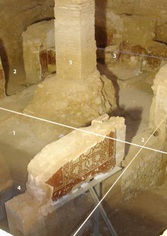 Vivienda excavada en 2005 bajo la ampliación almorávide de la Mezquita de al-Qarawiyyin (Fez). Foto: A. Ettahiri, A. Fili, J.P. Van Staëvel (2012).Fez, a historical capital in northern MoroccoNovember 16, 20167:30 p.m.CóRDOBACasa Árabe headquarters (at Calle Samuel de los Santos Gener, 9). 7:30 p.m. Free entrance until the event’s capacity is reached.In French, with simultaneous translation into Spanish.The conference will be held on November 16 at Casa Árabe’s headquarters in Cordoba.This conference, to be held at the Casa Árabe headquarters in Madrid, closes the series dedicated to the great capitals of the Islamic world.In the late eighth century, Idris bin Abd Allah created Madinat Fas, on the right bank of a river bearing the same name. At the beginning of the ninth century, his son strengthened this city as the capital of the Idrisid dynasty, creating another town on the left bank of the river (809).For two centuries, Fez preserved both centers of population, one facing the other in constant rivalry. In the late eleventh century, the Almoravid emir, Yusuf ben Tashufin, did away with this duality, uniting both areas behind one single city wall and building a citadel at the top. Years later, the Almohads besieged Fez for a long period of time, until in 1145 they managed to enter it, harshly punishing the city, then destroying its citadel and walls, which the Almohad caliph al-Nasir would have rebuilt in 1212.In the middle of the same century, the Merinid dynasty conquered Fez, making it their capital city while creating a new duality by founding the “new Fez,” Fez Al-Jadid, an area dedicated mainly to the court and government, whereas the old Fez concentrated on handicrafts and trade.Today Fez is a lively city of great importance in religious and cultural affairs. It is the third largest city in Morocco and one of those most visited by tourists. It is a UN World Heritage site with a rich historical past forced to live side-by-side with its intense modern life.
Vivienda excavada en 2005 bajo la ampliación almorávide de la Mezquita de al-Qarawiyyin (Fez). Foto: A. Ettahiri, A. Fili, J.P. Van Staëvel (2012).Fez, a historical capital in northern MoroccoNovember 16, 20167:30 p.m.CóRDOBACasa Árabe headquarters (at Calle Samuel de los Santos Gener, 9). 7:30 p.m. Free entrance until the event’s capacity is reached.In French, with simultaneous translation into Spanish.The conference will be held on November 16 at Casa Árabe’s headquarters in Cordoba.This conference, to be held at the Casa Árabe headquarters in Madrid, closes the series dedicated to the great capitals of the Islamic world.In the late eighth century, Idris bin Abd Allah created Madinat Fas, on the right bank of a river bearing the same name. At the beginning of the ninth century, his son strengthened this city as the capital of the Idrisid dynasty, creating another town on the left bank of the river (809).For two centuries, Fez preserved both centers of population, one facing the other in constant rivalry. In the late eleventh century, the Almoravid emir, Yusuf ben Tashufin, did away with this duality, uniting both areas behind one single city wall and building a citadel at the top. Years later, the Almohads besieged Fez for a long period of time, until in 1145 they managed to enter it, harshly punishing the city, then destroying its citadel and walls, which the Almohad caliph al-Nasir would have rebuilt in 1212.In the middle of the same century, the Merinid dynasty conquered Fez, making it their capital city while creating a new duality by founding the “new Fez,” Fez Al-Jadid, an area dedicated mainly to the court and government, whereas the old Fez concentrated on handicrafts and trade.Today Fez is a lively city of great importance in religious and cultural affairs. It is the third largest city in Morocco and one of those most visited by tourists. It is a UN World Heritage site with a rich historical past forced to live side-by-side with its intense modern life. -
 Vivienda excavada en 2005 bajo la ampliación almorávide de la Mezquita de al-Qarawiyyin (Fez). Foto: A. Ettahiri, A. Fili, J.P. Van Staëvel (2012).Fez, a historical capital in northern MoroccoNovember 17, 20167:00 p.m.MADRIDCasa Árabe Auditorium (at Calle Alcalá, 62) 7:00 p.m. Free entrance until the event’s capacity is reached.In French, with simultaneous translation into Spanish.This conference, to be held at the Casa Árabe headquarters in Madrid, closes the series dedicated to the great capitals of the Islamic world.In the late eighth century, Idris bin Abd Allah created Madinat Fas, on the right bank of a river bearing the same name. At the beginning of the ninth century, his son strengthened this city as the capital of the Idrisid dynasty, creating another town on the left bank of the river (809).For two centuries, Fez preserved both centers of population, one facing the other in constant rivalry. In the late eleventh century, the Almoravid emir, Yusuf ben Tashufin, did away with this duality, uniting both areas behind one single city wall and building a citadel at the top. Years later, the Almohads besieged Fez for a long period of time, until in 1145 they managed to enter it, harshly punishing the city, then destroying its citadel and walls, which the Almohad caliph al-Nasir would have rebuilt in 1212.In the middle of the same century, the Merinid dynasty conquered Fez, making it their capital city while creating a new duality by founding the “new Fez,” Fez Al-Jadid, an area dedicated mainly to the court and government, whereas the old Fez concentrated on handicrafts and trade.Today Fez is a lively city of great importance in religious and cultural affairs. It is the third largest city in Morocco and one of those most visited by tourists. It is a UN World Heritage site with a rich historical past forced to live side-by-side with its intense modern life.
Vivienda excavada en 2005 bajo la ampliación almorávide de la Mezquita de al-Qarawiyyin (Fez). Foto: A. Ettahiri, A. Fili, J.P. Van Staëvel (2012).Fez, a historical capital in northern MoroccoNovember 17, 20167:00 p.m.MADRIDCasa Árabe Auditorium (at Calle Alcalá, 62) 7:00 p.m. Free entrance until the event’s capacity is reached.In French, with simultaneous translation into Spanish.This conference, to be held at the Casa Árabe headquarters in Madrid, closes the series dedicated to the great capitals of the Islamic world.In the late eighth century, Idris bin Abd Allah created Madinat Fas, on the right bank of a river bearing the same name. At the beginning of the ninth century, his son strengthened this city as the capital of the Idrisid dynasty, creating another town on the left bank of the river (809).For two centuries, Fez preserved both centers of population, one facing the other in constant rivalry. In the late eleventh century, the Almoravid emir, Yusuf ben Tashufin, did away with this duality, uniting both areas behind one single city wall and building a citadel at the top. Years later, the Almohads besieged Fez for a long period of time, until in 1145 they managed to enter it, harshly punishing the city, then destroying its citadel and walls, which the Almohad caliph al-Nasir would have rebuilt in 1212.In the middle of the same century, the Merinid dynasty conquered Fez, making it their capital city while creating a new duality by founding the “new Fez,” Fez Al-Jadid, an area dedicated mainly to the court and government, whereas the old Fez concentrated on handicrafts and trade.Today Fez is a lively city of great importance in religious and cultural affairs. It is the third largest city in Morocco and one of those most visited by tourists. It is a UN World Heritage site with a rich historical past forced to live side-by-side with its intense modern life.
Prof. Dr. Abdallah Fili (Université Chouaib Doukkali, El Jadida)
A professor of Moroccan History and Archeology at the University of El Jadida, Fili holds a PhD in Archeology from the University of Lyon, under the direction of Pierre Guichard and André Bazzana. He has taken part in several archeological excavation and research projects in Sijilmasa, Fez, Volubilis, El Jadida, Aghmat, Safi and Azemmour. In 2004, along with Jean-Pierre Van Staevel, he discovered the birth site of the Almohad Mehdi, Ibn Tumart, at Igiliz of the Hargha, upon which they have completed several excavation campaigns in recent years.
Prof. Dr. Alastair Northedge (Université Paris 1 Panthéon-Sorbonne)
An archeologist and Islamic art historian of British origin, Northedge is a professor of Islamic Archeology at the Université Panthéon-Sorbonne and a member of the Orient and Mediterranean Laboratory (UMR 8167): Medieval Islam. He was the director of the Council for British Research in the Levant. He is the main specialist in the study of the Archeological Site of Samarra in Iraq, one of the most extensive archeological sites in the world, classified as a UNESCO World Heritage Site, with regard to which he has co-directed the project “The Samarra Archaeological Survey.”
Prof. Dr. Alberto León (University of Cordoba)
A tenured professor of Medieval Archeology at the University of Cordoba, León holds a university degree in Philosophy and Letters (Geography and History Section) from the University of Granada (1993) and a PhD in Philosophy and Letters (Geography and History Section) from the University of Cordoba (2001). He is a specialist in the Urbanism of Al-Andalus, medieval defensive architecture and urban archeology management.
Dr. Antonio Orihuela (CSIC-School of Arab Studies)
Holder of a degree in Architecture from the E.T.S. of Architecture in Barcelona and a PhD from the University of Seville, Orihuela earned the special PhD award for his thesis on “Nasrid Homes and Palaces.” He was a municipal architect in Granada until 1988, the year when he began to work at Granada’s School of Arab Studies, belonging to the Spanish National Research Council (CSIC), of which he is currently the director. He specializes in Islamic architecture and is a member of the research group “City Archeology and Architecture Laboratory” (LAAC). He was also an associate professor in the Department of Graphic Architectural Expression at the E.T.S. of Architecture at the University of Granada from 1994 to 1998.
Prof. Dr. Hugh Kennedy (SOAS, University of London)
An English historian and linguist, Kennedy is a professor of Arabic in the Near and Middle Eastern Languages and Cultures Department at the University of London, having become one of the most prestigious specialists worldwide in the medieval Islamic history of Europe and Asia. He is a member of the Center for Iranian Studies and the London Middle East Institute (LMEI) at the School of Oriental and African Studies. He currently co-directs the project “Economic Integration and Social Change in the Islamic World System, 800-1000CE” and has published a diverse range of historical studies which mainly revolve around the ancient territories of Syria, Iraq and Iran.
Prof. Dr. Miguel Ángel Tabales (University of Seville)
A tenured professor of Archeology with the Department of Architectural Constructions at the University of Seville, Tabales has completed numerous urban excavations in Seville and has become the main researcher of Islamic urbanism in this city. He currently runs the prestigious journal Arqueología de la Arquitectura, published by the Spanish National Research Council and the University of the Basque Country. For several years, he has taken over the management of research work, administration, preservation and dissemination of archeological subject matter for the monumental site run by the Royal Alcázar of Seville Board of Trustees.
Dr. Julio Navarro Palazón (CSIC-School of Arab Studies)
A scientist with the CSIC, he holds a PhD in Islamic Archeology and currently coordinates the tasks of the City Archeology and Architecture (LAAC) research group, which is run under the School of Arab Studies of Granada, belonging to the Spanish National Research Council (CSIC). He is one of the main researchers on Islamic architecture and urbanism worldwide. He has excavated several sites in Spain and abroad.
Dr. Patrice Cressier (CNRS, France)
With a PhD in Islamic Art History and Archeology from the Université de Paris IV-Sorbonne, Cressier is a researcher at the Centre National de la Recherche Scientifique and a member of the CIHAM-UMR in Lyon. He was named a knight of the Ordre des Palmes Académiques on October 31, 2002 and has been a member of the German Archeological Institute. He has been the Director of Studies (Ancient and Medieval) at Casa de Velázquez (1994-2002) and a member of the UMR 5648 laboratory board (“History and archeology of medieval Christian and Muslim worlds”) since this team was created at the CNRS. He has been a member of the technical commission of the Monumental Ensemble of the Alcazaba in Almería (Department of Culture of the Autonomous Regional Government of Andalusia) and has directed several monographs, congresses and international projects, amongst which we could highlight the excavations of Sabra al-Mansuriya (Kairouan, Tunisia) between the years of 2003-2008.
Dr. Rafael Blanco (University of Cordoba)
A contracted researcher with the University of Cordoba, Blanco holds a degree in Art History from the University of Cordoba (2005) and an official inter-university Master’s degree in Archeology and Heritage from the University of Cordoba, University of Huelva, University of Malaga and Universidad Pablo de Olavide (2008), as well as having earned his PhD in Archeology from the University of Cordoba. A specialist in the domestic architecture of Al-Andalus and Islamic urbanism, as well as a coordinator of different scientific culture projects within the Sísifo Research Group (University of Cordoba).
Dr. Sophie Gilotte (CNRS, France)
With a PhD in Art History and Islamic Archeology (Université de Paris IV-Sorbonne) in 2004, Gilotte is a specialist in the Muslim era on the Iberian Peninsula and in North Africa, and she is a member of the CNRS, Ciham/UMR-LYON. She has been a director of excavations at the Albalat site and president of the Madinat Albalat Association (Cáceres), as well as heading the Hoffmeyer Historical Institute project (IAM / CCHS-CSIC, Spain). She has directed or co-directed several excavations in France and Spain, and she has taken part in the Madinat al-Zahra research and development project for hardware registration.
Prof. Dr. Stéphane Pradines (Aga Khan University, United Kingdom)
With a PhD in Islamic Archeology from the Université Sorbonne Paris-IV, Pradines is a professor at the Institute for the Study of Muslim Civilisations, Aga Khan University (United Kingdom). He is a specialist in the archeology of the Middle East and East Africa. He has directed several excavations on the medieval Islamic world in Tanzania, Kenya and Egypt. He is the main specialist on the Islamic architecture and urban archeology of Cairo, with regard to which he is currently heading a project on its fortifications and urbanism, with a special focus on the eras of the Fatimids and Ayyubids. He was responsible for Islamic Archeology at the IFAO (Cairo) from 2001 to 2012 and is a professor of Islamic Archeology at the University of Cairo, the city where he created the first Islamic Archeology Field School in in Egypt. He is also an associate researcher at the CNRS in Paris, Orient et Mediterranée, the editor of Islamic Archeological Studies, a proofreader for the Journal of Islamic Archaeology and a member of the editorial team of the Journal of the Dominican Institute (MIDEO, Cairo).
Thursday, May 5, 2016
Damascus, Syria, by Hugh Kennedy (SOAS, University of London)
Thursday, May 26, 2016
Marrakesh, Morocco, by Patrice Cressier (CNRS, France)
Tuesday, June 9, 2016
Seville, Spain, by Miguel Ángel Tabales (University of Seville)
Wednesday, June 22, 2016
Murcia, Spain, by Julio Navarro Palazón (CSIC-School of Arab Studies)
Wednesday, June 29, 2016
Granada, Spain, by Antonio Orihuela (CSIC-School of Arab Studies)
Thursday, September 22, 2016
Cordoba, Spain, by Alberto León (University of Cordoba)
Thursday, September 29, 2016
Cordoba. Present (Spain), by Rafael Blanco (University of Cordoba)
Wednesday, October 19, 2016
Sabra al-Mansuriyya, Tunisia, by Sophie Gilotte (CNRS, France)
Thursday, October 27
Baghdad-Samarra, Iraq, by Alastair Northedge (Université Paris 1 Panthéon-Sorbonne)
Wednesday, November 16, 2016
Fez, Morocco, Abdallah Fili (Université Chouaib Doukkali, El Jadida)
Wednesday, May 4, 2016
Damascus, Syria, by Hugh Kennedy (SOAS, University of London)
Wednesday, June 8, 2016
Seville, Spain, by Miguel Ángel Tabales (University of Seville)
Thursday, June 23, 2016
Murcia, Spain, by Julio Navarro Palazón (CSIC-School of Arab Studies)
Thursday, June 30, 2016
Granada, Spain, by Antonio Orihuela (CSIC-School of Arab Studies)
Wednesday, September 21, 2016
Cordoba. Past (Spain), Alberto León (University of Cordoba)
Wednesday, September 28, 2016
Cordoba. Present (Spain), Rafael Blanco (University of Cordoba)
Thursday, October 20, 2016
Sabra al-Mansuriyya, Tunisia, by Sophie Gilotte (CNRS, France)
Wednesday, October 26, 2016
Baghdad-Samarra, Iraq, by Alastair Northedge (Université Paris 1 Panthéon-Sorbonne)
Wednesday, November 2, 2016
Marrakesh, Morocco, by Patrice Cressier (CNRS, France)
Thursday, November 17, 2016
Fez, Morocco, Abdallah Fili (Université Chouaib Doukkali, El Jadida)
November 2016
Cairo-Fustat, Egypt, Stéphane Pradines (Aga Khan University, United Kingdom)
Tuesday, May 10, 2016
Seville, Spain, by Miguel Ángel Tabales (University of Seville)
Wednesday, May 25, 2016
Marrakesh, Morocco, by Patrice Cressier (CNRS, France)
Tuesday, June 21, 2016
Murcia, Spain, by Julio Navarro Palazón (CSIC-School of Arab Studies)
Tuesday, June 28, 2016
Granada, Spain, by Antonio Orihuela (CSIC-School of Arab Studies)
Tuesday, September 20, 2016
Cordoba. Present (Spain), by Rafael Blanco (University of Cordoba)
Tuesday, October 18, 2016
Sabra al-Mansuriyya, Tunisia, by Sophie Gilotte (CNRS, France)
Tuesday, November 15, 2016
Fez, Morocco, Abdallah Fili (Université Chouaib Doukkali, El Jadida)
Casa Árabe and Fundación Tres Culturas del Mediterráneo
The Sísifo Research Group of the Archeology Department at the University of Cordoba

